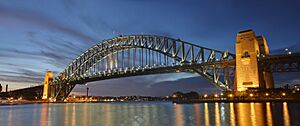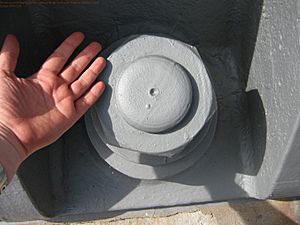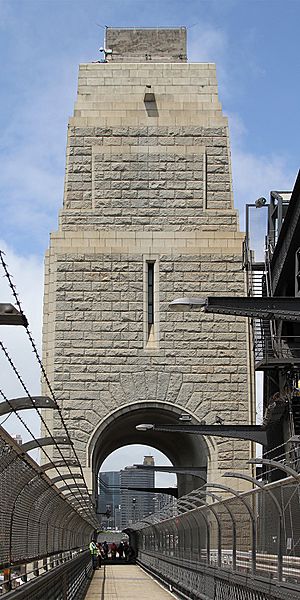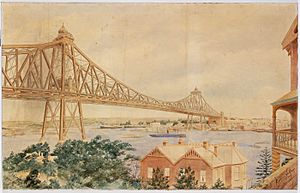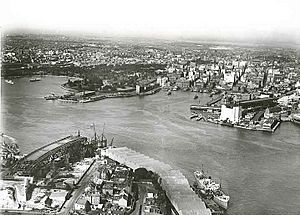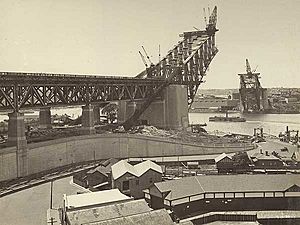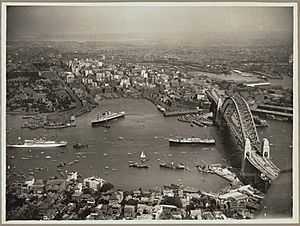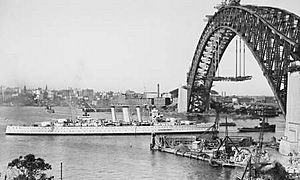Sydney Harbour Bridge facts for kids
Quick facts for kids Sydney Harbour Bridge |
|
|---|---|
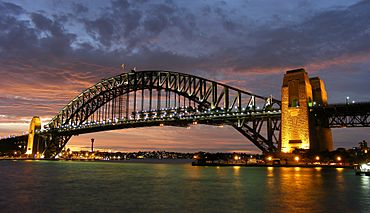 |
|
| Coordinates | 33°51′08″S 151°12′38″E / 33.85222°S 151.21056°E |
| Carries |
|
| Crosses | Port Jackson (Sydney Harbour) |
| Locale | Sydney, Australia () |
| Official name | Sydney Harbour Bridge |
| Owner | Government of New South Wales |
| Maintained by | Roads and Maritime Services |
| Preceded by | Gladesville Bridge |
| Characteristics | |
| Design | Through arch bridge |
| Total length | 1,149 m (3,770 ft) |
| Width | 48.8 m (160 ft) |
| Height | 134 m (440 ft) |
| Longest span | 503 m (1,650 ft) |
| Number of spans | 1 |
| Clearance below | 49 m (161 ft) at mid-span |
| History | |
| Constructed by | Dorman Long & Co |
| Construction begin | 28 July 1923 |
| Construction end | 19 January 1932 |
| Opened | 19 March 1932 |
| Inaugurated | 19 March 1932 |
| Statistics | |
| Toll | Time of day tolling (southbound only) |
| Official name | Sydney Harbour Bridge, Bradfield Hwy, Dawes Point - Milsons Point, NSW, Australia |
| Type | National Heritage List |
| Designated | 19 March 2007 |
| Reference no. | 105888 |
| Class | Historic |
| Place File No. | 1/12/036/0065 |
| Official name | Sydney Harbour Bridge, approaches and viaducts (road and rail); Pylon Lookout; Milsons Point Railway Station; Bradfield Park; Bradfield Park North; Dawes Point Park; Bradfield Highway |
| Type | State heritage (complex / group) |
| Designated | 25 June 1999 |
| Reference no. | 781 |
| Type | Road Bridge |
| Category | Transport - Land |
| Lua error in Module:Location_map at line 420: attempt to index field 'wikibase' (a nil value). | |
The Sydney Harbour Bridge is a famous bridge in Sydney, Australia. It connects the northern and southern parts of the city across Port Jackson (Sydney Harbour). People can cross the bridge by car, train, walking, or cycling. There is also a tunnel that goes under the harbour. The bridge is a major tourist attraction because of its amazing views. Many people enjoy the 'BridgeClimb', where you can climb to the top of the arch. Luna Park Sydney is also right next to the bridge.
The bridge is 1,149 metres (3,770 feet) long and 49 m (161 ft) wide. Its highest point is 134 m (440 ft) tall. Building the bridge started on 19 March 1923 and finished in 1932. John Bradfield was the main engineer who led the project. The bridge cost about AU£6.25 million to build, which was a lot of money back then. It was fully paid off in 1988.
Contents
Bridge Structure and Design
The Sydney Harbour Bridge connects Dawes Point in the south to Milsons Point in the north. The main part of the bridge has six lanes for cars. On the eastern side, there are two extra lanes that used to be for trams. There's a path for walkers on the eastern side and a special path for bikes on the western side. Between the main road and the bike path, there are two railway tracks for trains.
The main road across the bridge is called the Bradfield Highway. It's about 2.4 km (1.5 mi) long, making it one of Australia's shortest highways.
The Arch of the Bridge
The bridge's main feature is its huge arch. This arch is made of two large steel structures, each with 28 sections. The height of these sections changes, from 18 m (59 ft) in the middle to 57 m (187 ft) near the ends.
The arch spans 504 m (1,654 ft) across the harbour. Its highest point is 134 m (440 ft) above the water. On very hot days, the steel can expand, making the arch grow taller by about 18 cm (7.1 in)!
The entire steel structure of the bridge weighs about 52,800 tonnes (52,000 long tons; 58,200 short tons). The arch itself weighs 39,000 tonnes (38,000 long tons; 43,000 short tons). Most of the steel (about 79%) was shaped in England and then shipped to Australia. The rest came from Newcastle, Australia. Workers then put the steel together into girders and other parts at workshops near the bridge site.
The bridge is held together by six million rivets made in Australia. Rivets are like strong metal pins that are heated until red-hot, then hammered into holes to join steel plates. The largest rivets weighed 3.5 kg (8 lb) and were 39.5 cm (15.6 in) long. Using rivets was a common and trusted way to build large steel structures back then.
Pylons: The Bridge's Towers
At each end of the arch, there are two tall towers called pylons. They are 89 m (292 ft) high and covered with granite stone. These pylons were designed by a Scottish architect named Thomas S. Tait.
About 250 stonemasons (people who cut and shape stone) from Australia, Scotland, and Italy moved to a temporary town in Moruya, NSW, to work on the bridge. They quarried (dug out) about 18,000 m3 (635,664 cu ft) of granite for the pylons. The stone blocks were cut, shaped, and numbered, then shipped to Sydney.
The pylons themselves don't actually hold up the bridge's weight. They were added to make the bridge look more balanced and impressive. People were worried about how strong the bridge would be, so the pylons were included to make it look more secure.
Even though they weren't for support, all four pylons are now used. The south-eastern pylon has a museum and a tourist center with a 360-degree view. The south-western pylon holds cameras that watch traffic on the bridge. The two pylons on the north side have chimneys to let out fumes from the Sydney Harbour Tunnel.
History of the Bridge
Early Ideas for a Bridge
People started thinking about building a bridge across Sydney Harbour as early as 1815. A convict and architect named Francis Greenway suggested it to the governor. He thought a bridge would show how strong and grand the colony was.
Many other ideas for a bridge came up during the 1800s. There were suggestions for floating bridges, truss bridges, and high-level bridges. In 1900, the government even held a worldwide competition to design a harbour bridge. An engineer named Norman Selfe won a prize for his suspension bridge design, and later won another competition for a steel cantilever bridge. But due to money problems, construction didn't start.
Planning the Great Bridge
In 1914, John Bradfield became the "Chief Engineer of Sydney Harbour Bridge and Metropolitan Railway Construction." He worked on the project for many years and is known as the "father" of the bridge. Bradfield first preferred a cantilever bridge.
After World War I, plans for the bridge picked up again. Bradfield looked at bridge designs overseas. He decided that an arch design, similar to the Hell Gate Bridge in New York City, would also work well. In 1922, a law was passed to build a high-level bridge (either cantilever or arch) across the harbour. Companies from all over the world were invited to submit their designs.
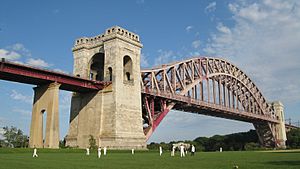
Twenty proposals came in from six companies. On 24 March 1924, a British company called Dorman Long and Co Ltd won the contract to build an arch bridge. Their design was cheaper and stronger for the heavy loads expected.
Bradfield and his team oversaw the building process. The bridge was designed to carry six lanes of road traffic, two railway tracks on each side, and a footpath. The railway tracks were connected to the underground Wynyard railway station. The eastern railway tracks were later changed into extra traffic lanes when tram services stopped in 1958. The main road on the bridge is named the Bradfield Highway in honor of John Bradfield.
Building the Sydney Harbour Bridge
Construction officially began on 28 July 1923. Many buildings on the north shore had to be knocked down to make way for the bridge. By September 1926, concrete supports for the bridge's approaches were in place.
Workers also built strong foundations to hold the huge weight of the arch. Large cranes were set up on each side of the harbour to lift men and materials. To keep the arch steady as it was built outwards, steel cables were passed through tunnels on each shore and fixed to the arch halves.
Building the arch started on 26 October 1928. The southern side was built first to check for any problems. The cranes slowly moved along the arches as they were built, until the two halves met in the middle. This happened on 19 August 1930. Workers then riveted the arch sections together, making it self-supporting.
Once the arch was complete, the cranes moved back down. Workers then built the roadway and other parts of the bridge from the center outwards. The vertical hangers were attached to the arch, and then horizontal beams were added. The deck for the road and railway was built on top of these beams. This was finished by June 1931.
The pylons were built on top of the support towers. Stonemasons and other workers quickly built them using granite and concrete. The last stone of the north-west pylon was placed on 15 January 1932.
On 19 January 1932, the first test train, a steam locomotive, crossed the bridge safely. In February 1932, the bridge was tested for three weeks by loading all four rail tracks with up to 96 steam locomotives! After these tests, the bridge was declared safe to open.
Building the bridge was dangerous work. Sixteen workers died during construction, though only two fell from the bridge. Many more were injured or suffered hearing loss from the loud work of riveting. Photos and films from the time show how brave the workers were during the Great Depression.
Opening Day: A Big Celebration
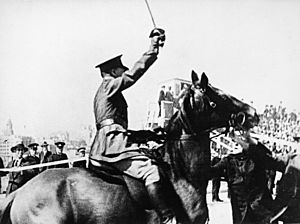
The Sydney Harbour Bridge officially opened on Saturday, 19 March 1932. Many important people were there, including the Governor of New South Wales and the Minister for Public Works. The Premier of New South Wales, Jack Lang, was supposed to cut a ribbon to open the bridge.
However, just as Lang was about to cut the ribbon, a man in a military uniform rode up on a horse. He cut the ribbon with his sword, declaring the bridge open himself! He was quickly arrested. The ribbon was tied back, and Lang performed the official opening. The bridge was named 'Sydney Harbour Bridge' and the road 'Bradfield Highway'. After this, there was a 21-gun salute and a flypast by the Royal Australian Air Force.
The man who cut the ribbon was Francis de Groot. He was part of a group called the New Guard, who disagreed with Lang's government. He was fined for his actions, but later won a lawsuit for wrongful arrest.
Despite the opening happening during the Great Depression, there were huge celebrations. These included decorated floats, a parade of ships under the bridge, and a Venetian Carnival. A message from a primary school far away in Tottenham was carried by relays of schoolchildren all the way to the bridge for the opening ceremony.
After the official events, the public was allowed to walk across the bridge. This was a special event that wasn't repeated until the bridge's 50th anniversary. It's estimated that between 300,000 and one million people took part in the opening festivities. This was a huge number, considering Sydney's population at the time was about 1.25 million.
To celebrate the opening, three postage stamps were issued. Many songs were written for the occasion, and in 1932, many babies were named Archie and Bridget in honor of the bridge. The bridge was seen as a symbol of hope during the Depression, and it was nicknamed "the Iron Lung" because it gave jobs to many workers.
Bridge Operations
In 2010, the Sydney Harbour Bridge was very busy. On an average day, it carried about 204 trains, 160,435 vehicles, and 1650 bicycles.
Images for kids
See also
 In Spanish: Puente de la bahía de Sídney para niños
In Spanish: Puente de la bahía de Sídney para niños


